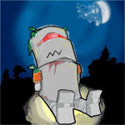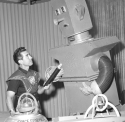|
NOTE: This thread has been around a while now, and I've basically given up trying to maintain it due to a busy personal life and the pretty fast rate new information is added. PM me if you feel anything should be added or changed here. Also, disregard the tutorials, I must have been really bored when I wrote those... Introduction Electronics are what make the modern world turn. They are quite literally everywhere now. You own anywhere from several hundred million to several billion transistors between your computers, cell phones, PDAs, TV sets, stereos, car, game consoles, and appliances. Even your dog probably has an electronic microchip implanted in it. If your grandpa has a pacemaker, than he has electronics keeping him alive. Unfortunately, despite being so ubiquitous relatively few people know how to build an electronic device from scratch. Even fewer work for the massive industries that quite literally manufacture our modern world. Most people seem content to push a button and watch millions of dollars of R&D do their bidding, with no concept of how it works beyond what they can physically see. The complex patterns seen on circuit boards inside computers are but a piece of abstract art that happens to be functional. But not anymore! This thread will be about getting started with hobbyist electronics. I'll try and explain some electronics theory and get beginners up to speed on how to put stuff together. Then I can go into more advanced topics as time progresses. As for my credentials I'm a 3rd year student studying Electrical Engineering. I'm bound to make a few mistakes somewhere along the line, so please correct me when I need correcting. If you have experience with electronics and would like to contribute, please do! I'll post pretty much anything relevant here in the OP. This is learning electronics though, so keep the projects relatively simple. I've built a collection of guides so far, but they're far from complete and they're kind of drafts right now. I'll clean them up and post them as I finish them. I'm also a terrible graphic artist, so please someone help pick that up. Helpful Resources
Projects
For Guitar Hero Wannabes franc0ph0bic posted:Yes, but only for guitar/bass related stuff. A good place for kits is Build Your Own Clone (http://www.buildyourownclone.com/) which sells a few overpriced kits which are clones of commercial effects. http://runoffgroove.com is a great site for more original schematics, but they do not sell kits. http://www.tonepad.com is another great site like this. The absolute best resource is http://www.diystompboxes.com/ which has the most active and productive effects building forum available. Thumposaurus posted:I would like to add these sites too: Where to Buy Components
Types of Parts General terms
Passive Components
Grey Area (usually considered active)
Active Components NOTE: Active Components typically have many ratings, so they have datasheets that describe them in detail. In most cases, you need the datasheet to know how to best use the component (at least at first).
Tools
Useful Stuff In This Thread
NOTE: This is my first big thread like this, so bear with me. PM me if you see something that needs to be added or changed, or just post it! clredwolf fucked around with this message at 15:51 on Feb 16, 2009 |
|
|
|

|
| # ? Apr 18, 2024 09:45 |
|
Current Electricity at it's most basic level is the manipulation of electrons. Those of you who took chemistry in high school probably remember those things, the little yellow balls orbiting the big circular thingie in the middle. Err, I mean the particles orbiting the nucleus of the atom. Electrons are one of the two basic particles that actually carries a charge (proton is the other), and despite being the smallest charge was the first to be discovered. The exact charge of the electron has been quantified accurately enough for practical use, and actually getting the drat things to do something useful is easier than you think. In dealing with electrons, you're also dealing with electromagnetic fields. You already have plenty of experience with those. Light, for one, is an electromagnetic field. So are radio waves, X-rays, and microwaves you cook your Ramen with. You may know you can use things like fiber optic cables to carry light across long distances. Well, light is just an electromagnetic signal at a very, very high frequency. So you can do the same thing with lower frequencies, aka 'normal' electricity. I'll talk more on frequency later. For now, remember that for lower frequencies (up to Gigahertz ranges, just now getting into Terahertz) you can send an electromagnetic field through a wire. If all that frequency talk doesn't make sense, don't worry. It's only important later. When you send a signal through a wire, there are two components to it, the electric component and the magnetic component. The magnetic component is easier to understand, so I'll start there. Basically, imagine a giant tube in a loop. Or be lazy and let me draw it for you:  Ok, now inside this loop are little balls. These represent electrons.  In reality, those 'balls' would be extremely small. Think of it more as an 'electron sea' inside that tube. It's actually good at this point to talk about liquid as an analogy for electrons, as it holds up pretty well for basic electronics. Everyone has some familiarity with basic plumbing, but not everyone knows what's going on inside their cell phone. So for now, think of a lot of water molecules in a tube, or something. Now we want to make these balls move. Alright Einstein, how would you make a bunch of liquid move? That's right, a pump.  Your little electron sea is now moving through the loop. This is exactly what happens in a wire when it's attached to a current source. We represent this in electronics as a little circle with an arrow through it. The wire we represent simply with a line.  This is your first taste of a schematic diagram. I promise you'll see a ton more later. This is also the first time you've seen current. Current is easy. Think of it as a 'density' measurement. It's the number of electrons passing through a point in a given period of time. Current is measured in units of 'Amperes', or amps for short. An amp is the same as 6.24*10^18 electrons passing through a point in a second. That's a lot of electrons too, so you can get a feeling for how crazy some of the measurements in electronics can get. But anyways, you can now tell your current source to pass an amp of current through the wire.  What does this mean for us now? Well, believe it or not, pushing all that current through that little wire makes a magnetic field. Yes, you have now created an electromagnet, at least in theory. I can go into a whole ton of formulas describing this magnetic field around the wire, but that's beyond what we're trying to do. Just remember, amps means magnetics, which is important when we talk about some later components. It's also possible to do the reverse. You can take a magnetic field and induce a current. This is exactly how generators work. So generators, from the little Honda you have in your toolshed to giants of industry powering entire cities, are basically current sources. You may have heard of alternating current. This is what generators make (or at least good ones). You deal with current in other ways in your life, but we'll talk about those later. -More to come later- clredwolf fucked around with this message at 06:58 on Jan 8, 2008 |
|
|
|
It seems like you are planning on running through the basics of a standard circuits 101 course from most universities. While informative, you might be going a little overboard for a single thread. If there isn't already a resource out there on the interweb that you like for this purpose, it might be better to host a tutorial somewhere and link it here, and keep the thread for questions.
|
|
|
|
That's kind of the problem. That 'Lessons in Electric Circuits' book is great and all, but it's kind of dry. I definitely tend to have a hobbyist slant to this, but basics are basics.
|
|
|
|
clredwolf posted:That's kind of the problem. That 'Lessons in Electric Circuits' book is great and all, but it's kind of dry. I definitely tend to have a hobbyist slant to this, but basics are basics. I think his basic idea was that if you want to continue it would probably be better to do everything on a blog, Google Docs, or something like that and linking it in rather than having to edit the OP every time or reply to yourself.
|
|
|
|
I did this a few years ago for a "Science with Swears" thread in GBS. It might make understanding basic electronics a little less "dry":  Let me know if you want the ones I did on vacumn tubes as well (for historical pusposes or whatever faggy things you like to do with them)
|
|
|
|
In no way should you be discouraged from continuing this.
|
|
|
|
I wish I could vote this thread a ten, just to encourage Jairbreakr.
|
|
|
|
every time I try to understand how an opamp works I have an internal dialogue not unlike one of those cartoons.
|
|
|
|
OP, Please continue, and help us out with some good starter stuff to build/make to pique our collective interest. What tools do I need to be a badass like yourself?
|
|
|
|
async1ronous posted:I wish I could vote this thread a ten, just to encourage Jairbreakr. If the OP wishes, I can try to put down some of what I learned in College (Electronics control at BCIT) into a more obscene format. Its been awhile, but some things you nver forget, like ohms law.
|
|
|
|
Doesn't logical current flow in the opposite direction from the actual electrons? It seems like the arrow should flip directions when you change scale from "look electrons" to the abstract, line=wire level.
|
|
|
|
I love little projects like installing LEDs in various things, and it's been years since we covered the bit on electricity in physics. Please teach on!
|
|
|
|
ejstheman posted:Doesn't logical current flow in the opposite direction from the actual electrons? It seems like the arrow should flip directions when you change scale from "look electrons" to the abstract, line=wire level. Its called hole flow, where you represent the current not as a flow of electrons, but as a flow of holes. That in itself confuses the hell out of people, and I'm not sure if it would help or hinder understanding. Jailbrekr fucked around with this message at 07:03 on Jan 8, 2008 |
|
|
|
dhrusis posted:What tools do I need to be a badass like yourself? Tools of the trade: Solder  Stiff Hot Pointy Thing  Breadboard  Pocket Protector  Multimeter  Jairbrekr posted:If the OP wishes, I can try to put down some of what I learned in College (Electronics control at BCIT) into a more obscene format. Its been awhile, but some things you nver forget, like ohms law. Yes, electronics needs way more sex. ejstheman posted:Doesn't logical current flow in the opposite direction from the actual electrons? It seems like the arrow should flip directions when you change scale from "look electrons" to the abstract, line=wire level. This is what the industry likes to call a 'gently caress up'. Thanks to that little error some NASA drone just crashed into the side of Pluto unexpectedly. Should be fixed now. clredwolf fucked around with this message at 07:04 on Jan 8, 2008 |
|
|
|
Now this is a thread I can get behind. I'd like to put forward Sparkfun Electronics (https://www.sparkfun.com) as another awesome source for electrical stuff. Pre-designed and printed boards for lots of cool things (GPS modules, Accelerometers, Cellphones, LCDs, touch-pads etc etc). They also have a nice tutorial for getting you started with programming micro-controllers (even has a $30 kit you buy to go along with it that includes everything they talk about in the tutorial). As far as simple but fun poo poo to build that doesn't require much knowledge, make a simple coilgun from a disposable camera (google can find a guide for you Im sure). With an hour or so of work you could probably start shooting small nails at your cat and at the same time learn the basics of resistance/capacitance voltage/current etc. What a deal! That's how I started atleast... now I have a 4 stage 2.5 kilo-joule coilgun in my basement that can put 3" pieces of steel rod into a phone-book...
|
|
|
|
If anyone is interested in going beyond the basics you are really going to need more than the above tools. Get an oscilloscope and learn to use it. Scoping out ebay is also useful. Sometimes you can find a decent deal on there buy you have to look frequently. If you want new, you can get a digital 60Mhz tek scope for less than 1K. Mainly scopes are used for looking at signals/waveforms. When I am troubleshooting something its generally the first tool I grab after making sure everything is getting proper power. Also, don't cheat yourself and get a super cheap soldering iron. You can get a metcal/OKI now for under 200$ off ebay or even new. They heat up instantly and don't cool down at all while soldering. The only disadvantage is that you need to treat them nice. The handset cable is actually a mini=coax cable. And if you abuse it badly it will break. Ebay is pretty much the best source for lots of little poo poo you might need like passive components (resistors, caps etc). I usually just get a large set of various axial components for 25$. SMT stuff is even cheaper. I'm not so much into the anymore but I can probably answer most questions people have. I was an R&D electronics tech at a Magna Donnelly for a few years as well as Invensys. Most of my job was reverse engineering competitors products, prototyping, designing test equipment, and component research. So I'm pretty familiar with most aspects of trying to rig something together with minimal facilities.
|
|
|
|
I would say that diodes, including LEDs, are passive semiconductor devices, and not active. Also, an IC is neither active or passive by definition.
|
|
|
|
drat I can't wait to get home in a few months and start posting updates in this thread. I'm self-taught in my electronics but I've managed to learn enough about micro controllers and general switching circuits to get me where I want to be. Back in high school (only 4 years ago now) my final year major design project for design and tech was a solar powered robotic lawn mower, I already knew basic electronics at that point but I was determined to make this thing and learn micro controllers and solid state circuits at the same time (big mistake!). Long story short I made the thing and it worked for about 5 mins before the MOSFETs started to die seemingly at random, I must have gone through about 20 fets before I ran out of time in that project. Turns out I knew dick about driving inductive loads with solid state devices and I had no clamping diodes or anything special to drive the MOSFETs, and so the reverse voltage spikes from the motors were nuking my control circuit. However now that I know better and seeing as I kept all the mechanical stuff from the project I think I'll give it another go, however this time I'm definitely going to do it properly and add in tons of cool functionality that I wouldn't have before (like a wireless link to my computer so I can watch and drive it from my room).
|
|
|
|
I would like to add to the shopping sources: https://www.alliedelec.com (allied electronics) https://www.mouser.com (my personal favorite) https://www.allelectronics.com for misc. surplus stuffs https://www.newark.com when you enjoy wasting money and as a plug, you can buy small quantities from these manufacturers usually for much less than the distributors: https://www.analog.com https://www.microchip.com Additionally if you wish to add to your wisdom, may I plug: http://www.analog.com/library/analogDialogue/
|
|
|
|
http://www.avrfreaks.net is a great website for anyone wanting to use an atmel microprocessor. seconding http://www.mouser.com as a supplier, i buy all the stuff i cant find in the UK from there. The stuff I can find in the UK, I buy from http://www.rapidonline.com/
|
|
|
|
Phlegmbot posted:I would say that diodes, including LEDs, are passive semiconductor devices, and not active. If you want to use anything in an IC you need to power it hence it is active. PRO TIP: There are two main sources of power: Battery (DC) and Power outlet (AC). Most scenarios or tutorials you will read about are involving DC. AC and DC work quite differently and if you try use AC without knowing exactly what you're doing you will probably break your circuit, set it on fire, short-out the entire street and kill everyone (in that order). Caffeine Wolf fucked around with this message at 12:52 on Jan 8, 2008 |
|
|
|
Phlegmbot posted:I would say that diodes, including LEDs, are passive semiconductor devices, and not active. It's kind of a fuzzy point for diodes and LEDs, but I've always seen them listed as active devices. Wikipedia sort of tells me the same, if you want to trust it. If not, I've got several electronics textbooks that tell me the exact same thing in slightly more readable paragraphs. Also, ICs almost by definition have to consist of transistors, which are active devices. I think there might be one or two out there that are not active (but I have no idea what those would be, I just know it's possible), but 99% of them are active devices. Caffeine Wolf posted:PRO TIP: There are two main sources of power: Battery (DC) and Power outlet (AC). Most scenarios or tutorials you will read about are involving DC. AC and DC work quite differently and if you try use AC without knowing exactly what you're doing you will probably break your circuit, set it on fire, short-out the entire street and kill everyone (in that order). Oh we'll be getting there. AC by itself is not that scary, but 120/240V AC can get scary. 10,000V AC is ridiculously scary unless you're a goon photographer apparently. XFDRaven posted:Links theparag0n posted:Links Added to the OP. If it's not up there yet, give it a few. clredwolf fucked around with this message at 13:57 on Jan 8, 2008 |
|
|
|
Holy crap, my A in gen physics has nothing on this thread. I really should go and read up on the basic stuff because I'm loving this.
|
|
|
|
How could this thread have come so far without any mention of the fun-loving Arduino? I've always been interested in electronics, but recently i woke up and realised that i was a grown-up and could actually afford to get some decent equipment. Then i remembered that as a grown-up, i also had bills, so i went back to scavenging parts from here and there... Also, speaking of scavenging, here's my new toy:  I'm currently in the process of playing around with a few things involving the Arduino, some C code and a Wiimote. edit: for links, i've got a few decent ones for beginners. there's Electornics Projects which has some nice little projects for start-ups and also explains the different components in nice layman terms. and also the page on play-hookey.com this one Ooh and what electronics megathread could be complete without a link to MAKE Magazine? H0TSauce fucked around with this message at 16:03 on Jan 8, 2008 |
|
|
|
H0TSauce posted:How could this thread have come so far without any mention of the fun-loving Arduino? Links will be added (when I get some more free time). Also, if you like the Arduino, try out an FPGA-based board sometime. You'll have to use Verilog (for the FPGA) and C (for the included ARM processor), but they're stupidly powerful for something hobbyist. FPGAs are basically a reprogrammable digital chip. If you've used a PLA before, same idea except you can reprogram it as many times as you want. They're amazingly powerful, and pretty cheap for what they do.
|
|
|
|
BEfore I go to work, here is more than you'll ever need to know about a vacumn tube diode. Unless you're an audiophile, this is strictly historical and kinda gives you an idea of the era we evolved from. I'll get to work on something new tonight after work, work which is, coincidentially, for a fabless chip manufacturer.
|
|
|
|
Power is a good point that was brought up. This should probably be one of your first projects once you get a few tools for your bench. You can make a pretty decent from a few op amps and assorted passives. Or you can make one from an ATX power supply. It would be limited to +/-12 +/-5 +3.3 though. And the ATX power supplies can be finicky sometimes. Putting together a power supply is a pretty useful first project though.
|
|
|
|
This thread is fantastic. I'm looking forward to more lessons from Electronics 101 since the last class I took on this stuff was in high school, and all I did was electrolysis. Making hydrogen and copper plating stuff is cool and all, but isn't very useful.
|
|
|
|
I approve of this thread! I currently work as an R&D Electrical Engineer, so I'm sure I'll be following this thread. It can not be overemphasized how much of a difference a quality soldering iron makes when working on stuff. That $20 radioshack iron will probably solder two wires together, but there is no way you're going to solder fine pitch surface mount parts with it. If you do a lot of work with surface mount components then having a hot air gun also works well. Also, get a little squirt bottle full of flux and apply it liberally to things you wish to solder. Do that and use leaded solder (the lead free stuff sucks) and things will go much easier.
|
|
|
|
Hillridge posted:I approve of this thread! Thanks for the info. I'm getting tired of buying new tips and irons every few months. I'm also interested in what other tools are needed for a good hobbyist setup. Heat gun and a big old pile of heatshrink tubing are definitely on my list of things to get. Should I look for anything in particular in a heat gun? Are temperature/CFM/BTUs/etc important or will whatever's in stock at the local industrial electronics store be fine? I'm also interested in getting a vacuum rework station. How cheaply can I find a good one, and what brands should I look for? Last question, when I started tinkering with things as a kid, my dad instilled a fear of flux in me, because ZOMG ACID. As a result, I've never used it, to this day. How bad is flux really? Will it eat my skin if I spill it on myself or just hurt a bit? What safety precautions should I take? For other people who don't have tools yet, here are some of the things I find indispensable: - Jeweler's screwdrivers . These are tiny little screwdrivers. Don't get the crap ones from Radio Shack, they suck and will fall apart or even be defective out of the box. I once got one where the tip hadn't been stamped or ground or whatever they do to form them, so it was just a rounded cone instead of a Phillips. - Needlenose pliers. Obvious, probably. - "Helping Hands." Those things with a weighted stand, a magnifying glass and two alligator clips on adjustable arms, for holding tiny stuff you're working on. They have a tendency to tip over if you even look at them funny, so fasten them to your workbench somehow. - A jar of soldering iron tinner. This is an incredible time and frustration saver compared to tinning by hand. Everyone should have one (that reminds me, I need more). Sometimes if stuff won't fir in the helping hands for whatever reason, I just tape things to the board or my workbench while I solder them. - 3-claw part retriever. A little round thingy with a plunger on one end and a springy metal claw on the other. You push the plunger and the claw opens up, let go and it springs back. Great for retrieving fiddly bits that you dropped into the case of whatever you're working on.
|
|
|
|
Where can I find a decent program for drawing up schematics and (bread)board layouts? I'm in the process of designing my own Z80-based computer, but using Adobe Illustrator is too slow and using a pen and paper is difficult to iterate on. A program that will prevent me from doing something loving stupid like attempting to connect Vcc to GND would be even better.
|
|
|
|
I know it can be expensive, but anyone interested in this stuff should really try to get ahold of an oscilliscope and a function generator. It greatly enhances everything you might want to do. Oh, and all this piddly digital/LED/microncontroller stuff is boring. You guys need to try some real electronics: https://www.pupman.com Although, fair enough, perhaps that's not exactly for someone just learning electronics...
|
|
|
|
MooglyGuy posted:Where can I find a decent program for drawing up schematics and (bread)board layouts? I'm in the process of designing my own Z80-based computer, but using Adobe Illustrator is too slow and using a pen and paper is difficult to iterate on. A program that will prevent me from doing something loving stupid like attempting to connect Vcc to GND would be even better. I just found this a few minutes ago and it seems a pretty handy free program bundle, both a schematic designer and a PCB layout designer. Looks to be free because you can order PCBs through the program I believe. http://www.expresspcb.com/index.htm
|
|
|
|
Great thread and a great new forum!clredwolf posted:This is what the industry likes to call a 'gently caress up'. Thanks to that little error some NASA drone just crashed into the side of Pluto unexpectedly. Should be fixed now. I think the confusion comes from defining electrical current before the discovery of the electron. People knew that there was charge flowing, they just didn't know it was made up of discrete particles that were negative. As for learning the basics, see Troubleshooting Analog Circuits by Bob Pease (http://books.google.com/books?id=3kY4-HYLqh0C) for the passives (and for the breadboard picture from clredwolf) and the Handbook of Operational Amplifier Applications from TI (http://focus.ti.com/lit/an/sboa092a/sboa092a.pdf) for active, analog devices. I am a graduate student doing some mixed signal design and will be happy to answer questions.
|
|
|
|
Ugh, I made a big update and the power went out before I could submit it. I'll try to redo it now. edit: Alright, well it seems like the thread is slightly more serious now. I'll try to tone the 'humor' down and get some projects together for everyone. I can do some more of the '101' stuff later. Jailbrekr can still make sex jokes about holes and poo poo though. scopes posted:I just found this a few minutes ago and it seems a pretty handy free program bundle, both a schematic designer and a PCB layout designer. Looks to be free because you can order PCBs through the program I believe. It's a great little program actually, but it does no simulation and it does not automatically lay traces (which is half the reason to use a PCB making program). The free version of Eagle is a bit harder to use, but can automatically figure out the best way to connect everything together and lay traces for you. Just remembered to add this cool Java Circuit Simulator to the OP. It's a fun program to use, and an absolute must for newbies to play with. Basically it's a nice quick-and-dirty circuit simulator. Get a good feel for messing with schematics here. clredwolf fucked around with this message at 02:11 on Jan 9, 2008 |
|
|
|
Jairbrekr, I love you. clredwolf, that breadboard picture has me in stitches and remembering the good old days of TWO MILLION PROJECTS IN ONE electronics labs from Radio Shack!  For an excellent and humorous explanation of electricity and electronics, I recommend There Are No Electrons by Kenn Amdahl. Hell, for that matter his other books are a hoot, too. The absolute best beginner's reference by far, however, is unfortunately no longer in print, because Radio Shack betrayed us all and turned into a loving computer and cell phone store, the bastards. I'll never forgive them. Fake edit: HOLY poo poo YOU CAN GET IT FROM AMAZON ALONG WITH HIS OTHER BOOKS!!! I should really start building BEAM bots again...
|
|
|
|
Powdered Toast Man posted:I should really start building BEAM bots again... This is what I've been into lately and this forum popped up not long after I finished some as Christmas presents. Wish I had taken pictures.
|
|
|
|
Circumcision Hater posted:Last question, when I started tinkering with things as a kid, my dad instilled a fear of flux in me, because ZOMG ACID. As a result, I've never used it, to this day. How bad is flux really? Will it eat my skin if I spill it on myself or just hurt a bit? What safety precautions should I take? You don't use acid flux on electronics ever. What you want is rosin flux, Its pretty much inert, you could probably wipe your face with it with no ill effects.
|
|
|
|

|
| # ? Apr 18, 2024 09:45 |
|
3rd year ECE just wanting to say this thread is looking great. I am actually in the market for a nice oscilloscope now so I can work on some designs. I am really interested in a USB based solution since they seem to give a ton of the features of high end scopes while still being relatively cheap. And if you are going to be soldering lots of surface mount parts you might want to look into getting an air solder station instead of a iron based one. They use a solder paste instead of solder wire and a really fine nozeled hot air gun and by god do they make soldering .22" pitch parts easy. They really complement a nice soldering iron more than replace it since you are going to need the iron for larger parts, you can't really use paste to solder wires together, or for through hole parts. And for those of you who want to get into building your own PCB's we used http://www.4pcb.com/ in one of my classes and they offered pretty good rates. You provide them with a Layout file and they will make a pretty nice PCB. The instructors said we've ordered over 2000 boards from them and only 1 has had an error, and that was because two traces were too close together.
|
|
|
































